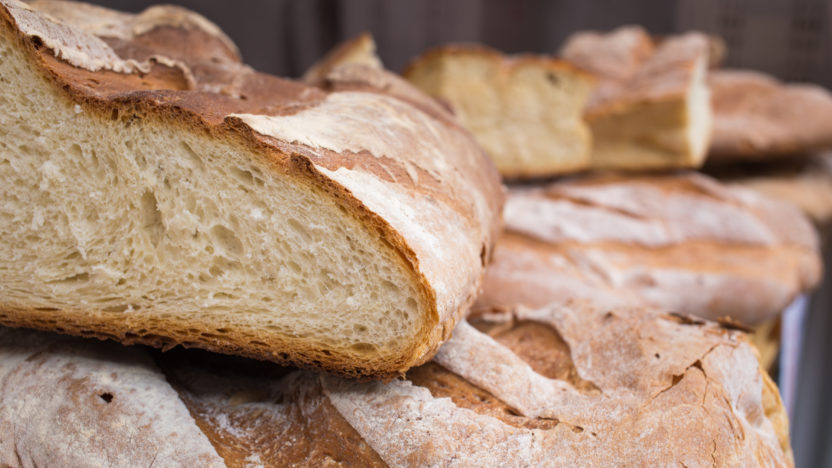 DOP
Toscana
DOP
Toscana
Tuscan Bread
The Tuscan Bread is a Designation of Protected Origin (DOP) present in the national list approved by the Ministry of Agriculture Food and Forestry, the requirements of which are regulated by the production discipline of the Tuscany Region.
Features
The name of protected origin Tuscan Bread is proper to the bread obtained through the ancient processing system in use in Tuscany.
This involves the exclusive use of sourdough (or sourdough), water and soft wheat flour type “0”, containing the wheat germ.
The Toscano D.O.P. Bread must have the following characteristics when it is placed on consumption:
– shape and weight: a weight between 0.45 and 0.55 kg, of diamond shape, locally called “philon”; weight between 0.90 and 1.10 kg or between 1.80 and 2.20 kg, rectangular in shape with beveled corners, locally called “wire”.
– thickness of the shape: between 5 and 12 cm;
– crust: crumbly and crispy, with matte dark hazelnut coloring;
– crumb: white, white-ivory, characterized by a non-regular alveolature;
– perfume: toasted hazelnut;
– taste: “silly”, that is, without salt and slightly acidic;
– Humidity: no more than 30% in weight.
Preparation
The raw material used for the preparation of the Tuscan PDO Bread is represented by soft wheat flour type “0”, containing the wheat germ, produced from wheat varieties grown, stored and moped exclusively in the production range.
For the preparation of flour to be used for the production of The Tuscan Bread, red cariosside varieties (type Centauro, Libra, Serio, Verna, Pandas) and varieties with white cariosside (type Mieti, Mec, Marzotto, Bolero) and their varieties are used “I think it’s a good thing that we’re going to be able to do that,” he said.
Additional varieties featuring Tuscan cereals can also be used, which are registered either with the Tuscan Germplasm Regional Repertory or the National Seed Register as a conservation variety.
The soft wheat produced in the delimited range before storage must be subjected to pre-cleaning treatments during which the light impurities of the mass are removed through suction or ventilation, while with a subsequent passage of carioxides through different mesh scans is guaranteed the removal of other coarse and minute impurities.
The milling is preceded by a further cleaning treatment that ensures the removal of any foreign bodies left after pre-cleaning.
Clean carioxides are then bathed with water. Wet caroxides remain at rest for at least 8 hours in order to ensure proper inhibition and facilitate subsequent removal of integuments avoiding the damage of the wheat germ.
The wetting phase is followed by the milling by cylinder mills equipped with machines equipped with a pair of metal cylinders of different diameter, with plansichter and what is necessary to obtain a flour of type “0”, containing the germ of Wheat.
The operating temperature inside the milling machines during the processing process must not exceed 40 degrees Celsius.
Immediately after milling, the flour must be stored at the mill for a period of no less than 10 days, starting from the end of the milling, in order to ensure the maturation processes take place.
It is forbidden to add any kind of food additive to flour.
Toscano Bread is obtained from the complete cooking of a conveniently yeasted dough prepared with soft wheat flour type “0”, containing the germ of wheat, water and sourdough.
The natural yeast used for the production of the Tuscan Bread consists of a portion of dough, coming from a previous processing, which stored in a suitable environment goes through a gradual process of fermentation and acidification.
This portion of sour dough, the so-called “mother yeast” or “mother”, properly refreshed, inserted into a new dough is able to cause leavening. At the end of the refreshments, a portion of pasta is “peeled” to ensure the sourdough for the next day.
In order to ensure the uniformity of the production process and the Maintenance by the Tuscan Bread of the characteristics of uniqueness, the bakers to replenish the sourdough use for this purpose a specific sourdough, such as or libeilized, which is added to soft wheat flour type “0” and water.
The production method of The Tuscan Bread involves the preparation of the so-called “biga” or first dough, which serves for the multiplication of the “natural yeast” refreshed.
For this purpose, knead the soft wheat flour type “0”, containing the wheat germ, with water and sourdough in the following proportions: to each kilogram of flour per yeast you must add at least 500 ml of water and at least 200 grams of sourdough.
After preparation the “biga” is left to rest for a period of time of no less than 8 hours, then the “biga” is used as a leaven agent for the preparation of the final dough.
For this purpose, the soft wheat flour type “0”, containing the wheat germ, is added water and biga in the following proportions: for each kilogram of flour, at least 550 ml of water and at least 200 g of biga are used for each kilogram of flour.
The dough for the Tuscan Bread can be done by hand or by machine.
The dough is then left to rest for at least 20 minutes.
It follows the phase of breakage during which the dough is divided into portions whose size varies depending on the weight and shape, the so-called “piece”, of the finished product. The break follows a rest period, lasting at least 15 minutes, which ensures a suitable oxygenation of the portions of dough prepared. After this period, the “panetti” is prepared, that is, to form-shape the portions of dough previously prepared, depending on the pieces. The “panetti”
they are then left to rest until the optimal rise
a period of no less than 2 hours and 30 minutes, after which, the forms of pasta are put in the oven for cooking.


